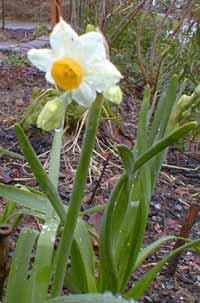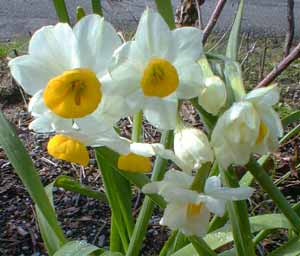
Narcissus
'Chinese Sacred Lily'
"When a daffodil I see
Hanging down his head toward me
Guess I may what must be:
First, I shall incline my head;
Secondly, I shall be dead;
Lastly safely buried."
-Robert Herrick,
Divination by a Daffodil
Divination by a Daffodil
The photo at left shows Narcissus tazetta var orientalis 'Chinese Sacred Lily,' giving us our very first narcissus bloom of the year. The first of this cultivar's buds opened on 31 January 2004. It is by a longshot the first of our narcissus to bloom, far ahead of even another N. tazetta cultivar, i.e., 'Minnow.'
The second photo is two weeks later at mid-February, with more blooms appearing, & the first blooms showing not the least bit of wear. There are still no other daffodils ready to bloom elsewhere in the gardens, though by mid-February a few others have fat buds of promise.
Commonly grown as a "forced" houseplant, Narcissus 'Chinese Sacred Lily' can be induced to bloom indoors in the middle of winter, not needing to be chilled beforehand.
If one wishes to force them, the method is simple. They are placed in shallow bowls of water, the bulbs stood upright & touching but not entirely submerged, kept at room temperature in a sunny location, with frequent water changes. The bulbs will begin growing immediately, & will bloom from three to five weeks after forcing begins.
 Alas, forced N. tazetta bulbs generally have to be discarded rather than put out into the garden, as they can take so long to recover energy for future blooms they frequently never do perform well ever again, although recovery is not entirely out of the question. If forced bulbs can be gotten into the ground outdoors immediately after blooms are spent but while its leaves are still healthy, & kept in a sunny moist location without drying out, they will have a chance of recovery in a couple of years. If they dry out too soon, they will go dormant without any chance to begin storing up energy for the future.
Alas, forced N. tazetta bulbs generally have to be discarded rather than put out into the garden, as they can take so long to recover energy for future blooms they frequently never do perform well ever again, although recovery is not entirely out of the question. If forced bulbs can be gotten into the ground outdoors immediately after blooms are spent but while its leaves are still healthy, & kept in a sunny moist location without drying out, they will have a chance of recovery in a couple of years. If they dry out too soon, they will go dormant without any chance to begin storing up energy for the future.If simply planted outdoors in Autumn to begin with, they are apt to produce fat, almost succulent leaves right away, so that stubby leaves are obvious in October, & thick & tall by November. A bit further south than us, they will even bloom by December, but never so early here on Puget Sound, though buds do appear by early January, & the first open flowers might be seen by the last day of January, certainly the first week in February.
They are not as hardy as the majority of narcissus & will not do well in gardens with very cold winters. Although 'Sacred Lily' is subject to winter frost damage because of leafing up before winter, in places where winter is truly temperate, the 'Chinese Sacred Lily' will usually be fine. The temperate microclimate of Puget Sound rarely burdens them, if they are provided with the sunniest best-draining locations possible. But a very wet winter or a very cold one can cause them either to rot or to skip a year flowering, so while they are worth a try, they're not entirely the most recommendable choice.
Ours during its first winter experienced several days in January under snowfall followed by temperatures into the twenties Fahrenheight followed by rains so hard there were floods around the county, all the conditions it deplores, but the stems already with flower-buds were undamaged, except one, & a snail seems to have climbed up to get that, the rough weather hadn't phased it. So with an ounce of luck, much hardier than usually credited.
The smallish flowers appear in multiples on each tall stem, white with short orange-yellow trumpets. Late frosts might shorten the presence of the blooms, just as frosts earlier threatened the leaves.
'Chinese Sacred Lily' is kind of an annoying cultivar name since it is neither Chinese nor a Lily. It is mildly shade-tolerant in warmer climates, but here in the Pacific Northwest we selected for them the sunniest position on a raised ledge with the sharpest drainage. We had only three bulbs, so planted them in a group together with two Fritillaria acmopetala & fifteen little bulbs of Camassia camassia which appreciate similar conditions.
Their comparative delicateness in the north is due to their semi-desert origin, which is fortunate for Southwest gardeners, as the majority of narcissi suffer in hot zones, but these do well in the deep South or along the Gulf Coast or Baja, where they are best planted in late summer since they are in full bloom at the height of winter.
The species has been cultivated in England since the 1590s or earlier, but was gardened for thousands of years in Egypt & Israel. Despite that it is not a Chinese plant, the Chinese do have their own sentiments about daffodils generally, which begin blooming during the first Moon of the Chinese calander, & are likened "water nymphs" because their bowed heads gaze into pools.